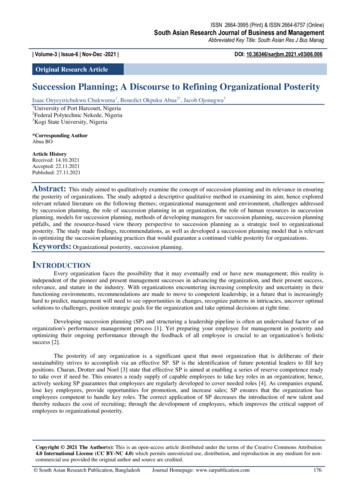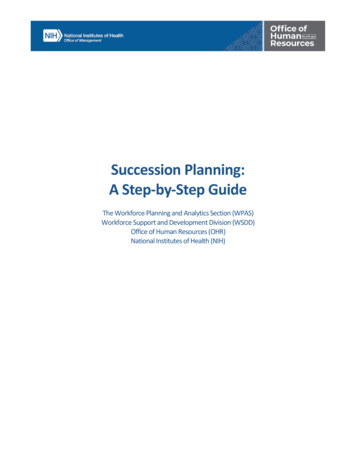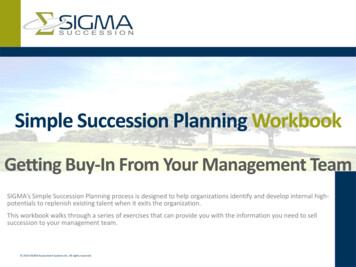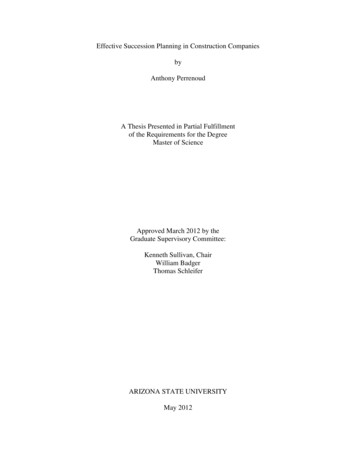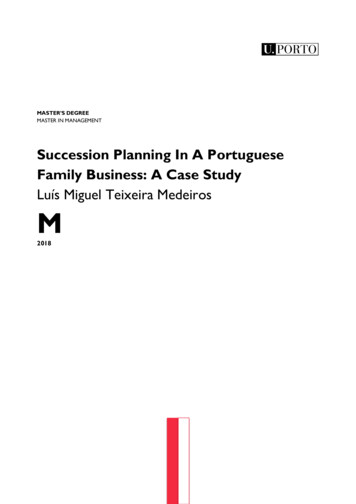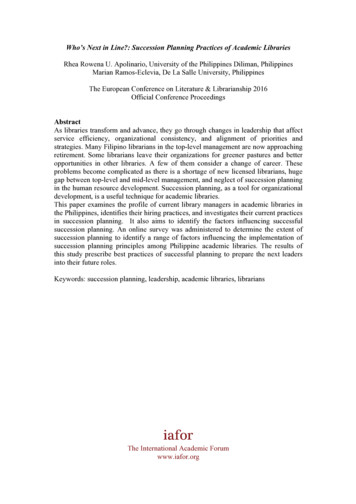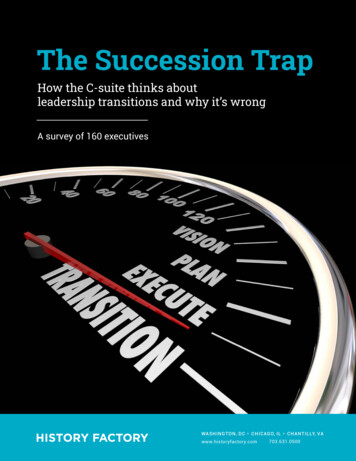
Transcription
The Succession TrapHow the C-suite thinks aboutleadership transitions and why it’s wrongA survey of 160 executivesWA S H I N G TON, D C C H IC AG O, I L C H A NTI LLY, VAwww.historyfactory.com703.631.05001
Q24CEO turnover rates are on the rise —but are companies prepared?In 2019, over 1,500 CEOs left U.S. businesses, marking the highest turnover rate since executivesearch firm Challenger, Gray & Christmas began tracking these departures nearly two decades ago.Among the world’s 2,500 largest public companies, CEO turnover is even more common, reaching arecord 17.5% in 2018, according to PwC.The pandemic may have hit pause on such transitions, but it was only a momentary blip. Turnoverrates began rebounding to 2019 levels as early as Q3 2020. In the first few months of 2021, we’veseen several high-profile corporate succession announcements, including Jeff Bezos at Amazon,Ken Frazier at Merck and Warren Buffett at Berkshire Hathaway, to name just a few. All signs pointSuccession planning importanceto a continued increase. After all, the pandemic accelerated the very forces that prompted the massexodus of CEOs in the first place: ongoing digital and workplace transformations, heightened culturaland societal pressures, and a rapidly evolving business landscape.Succession planning is more important thanever because the quickly evolving businesslandscape in the digital age makes beingprepared essentialSuccession planning is more important thanever because companies will need to refreshleadership more often in the coming years asa result of an evolving landscapeStrongly agree63%Strongly agree44%Agree26%Agree39%89%83%Given this trend, one would think that organizations would be more prepared. That’s not the case.In History Factory’s survey this year of 160 C-suite executives including 50 CEOs, board chairs andcompany founders — 57% of respondents say their companies don’t have documented plans in placefor executive transitions, despite nearly 90% agreeing that in today’s unpredictable environment,succession planning is more important than ever.Why the disconnect? Where are organizations struggling most with leadership transitions? And howcan they improve — before it’s too late?Our report answers all this and more. But the primary takeaway is this: Institutional memory matters.And not just when it comes to an outgoing leader’s personal legacy.2
The importance of transferringinstitutional knowledgeHewlett-Packard and Apple were both born in Silicon Valley garages and grew to becomesynonymous with American technological innovation.But in the mid-2000s, as the two companies underwent critical leadership transitions, oneemerged with its innovative DNA intact. The other did not. And it had everything to do with theability (or inability) to effectively transfer institutional knowledge — that is, the combinationof experiences, processes, data, expertise, values, and information possessed by the wholecompany — not just the legacy of the person in the corner office.That legacy at HP was about as epic ascan be. After all, for its countless innovativeachievements, the company is considered thesymbolic founder of Silicon Valley. In the 1990s,however, the company lost its “HP Way.” Whilethe founders’ personal legacies may have beenenshrined in business books and historical sites,the company’s successive leaders fumbled theinstitutional values and knowledge that madeHP great in the first place. As Financial Timesreported, this reached its nadir in the mid-2000swith a series of failed CEOs who, brought in fromthe outside, failed to “maintain or revive theinnovative heartbeat of the company.”Instead, they pursued business combinations and cost-cutting. As one software executivetold The New York Times while reflecting on HP’s acquisition of the British software companyAutonomy, “It was as if Alan Mulally left Boeing to join Ford as C.E.O., and announced sixmonths later that Ford would be making airplanes.”3
Apple’s transition from Steve Jobs to Tim Cook stands in stark contrast. Not that Jobs didn’ttake pains to preserve his own personal history with the company. In “Haunted Empire: AppleAfter Steve Jobs,” author Yukari Iwatani Kane caps off a description of Jobs’ memorial service— replete with performances by Joan Baez and Yo-Yo Ma — by noting, “Somehow he hadtranscended death to obsess over the launch of one last product: his own legacy.”The preservation of this legacy, however, didn’t come at the expense of effectively transferringApple’s institutional knowledge. In fact, Cook joined Apple’s executive team in 1998. When he firststarted, he eschewed a larger office to sit closer to Jobs on the executive floor. Though he wasn’ton the product design side of things like his boss, he ran the company’s operations with a level ofdemand and ambition that matched Jobs’ ethos. At the start of his tenure, for instance, Cook toldthe procurement team, “I want you to act like we are a 20 billion company,” despite Apple thengenerating only about 6 billion in yearly revenues. In his first memo to staff, he doubled down onhis commitment to Apple’s innovative DNA, encouraging employees “to be confident that Apple isnot going to change.”There’s a reason why, when asked which succession most closely exemplifies a best-case CEOtransition, Apple is far and away the top choice among our survey’s respondents.Which of the following examples most closely exemplifieswhat you would define as a best-case CEO transition?38%28%Apple:Steve Jobs toTim CookMicrosoft:Steve Ballmer toSatya Nadella13%13%GE:Jack Welch toJeff ImmeltGM:Dan Akerson toMary Barra8%Goldman Sachs:Lloyd Blankfein toDavid Solomon4
In leadership transitions,history mattersApple’s success (and HP’s struggle) underscores the importance of preserving and transferringinstitutional memory — not just an outgoing leader’s personal legacy. Our survey revealsthat executives recognize the importance of this heritage: 63% say that it is very important todocument the history and experience of the company and current leadership for the next leader.“History is the mother of innovation for any type of company,” a CEO respondent says,while another respondent posits that history “is the most important part of any businessplan, and that extends to succession.”From left, Henry Ford II, Henry Ford, and Edsel Ford, three generations of executive succession.Our work at History Factory over the past four decades has revealed this same fundamentaltruth. After announcing our own transition in 2021, we know that history will inform our continuedsuccession planning in the months to come.We hope that this report — which draws on data from a comprehensive survey we conductedin February and March 2021 to outline the challenges of leadership transitions and how tosuccessfully prepare for one — will convince you why history should inform yours, too.5
Why succession planning is so challengingOur respondents overwhelmingly agree that the evolving business landscape in the digital age makessuccession planning more important than ever. Yet only 43% have a documented plan in place.Why? Our experience and the survey results indicate four key reasons:1. An increasingly disruptive, digital and fast-paced business landscapeThe digital age, as McKinsey has written, ushered in “massive disruption” and turnover for businessleaders. Since 2000, more than half of Fortune 500 companies have been acquired, merged ordeclared bankruptcy. As we’ve seen with HP, this is particularly challenging in tech, where thepressure to continually innovate can be difficult to sustain over the long term.Merge the digital age with a challenging economicclimate and heightened societal pressure —be it #MeToo or reinvigorated movements forracial justice — and it’s no surprise that manyexpect turnover to continue apace. Though oursurvey finds that fewer than 20% of leadershiptransitions occurred because of crisis response,underperformance or scandal, that number isnot insignificant and is likely to increase postpandemic. In 2019, for instance, The ConferenceBoard found a record-high number of CEOs who“left their post as a result of an investigationrelated to their personal misconduct.”2. Transitions are often viewed through an individual, not organizational, lensWhile 57% of respondents say their organizations don’t have documented succession plans,a much greater percentage of executives say that they have taken proactive steps to formallycreate and reinforce their personal legacies (64% have done so, while 33% are considering it).Meanwhile, 84% of respondents agree (with 55% strongly agreeing) that a CEO or founder’s legacyoften overshadows the skillset and experience that a successor brings.6
To what extent have you taken proactive steps to create and reinforce your legacy?To what extent have you taken proactive steps to create and reinforce your %Completed59%Completed55%Completed54%Discussion with ownnetwork, peers,mentors or coachesFormal legacyplanningDiscussion regardinglegacy initiativeDiscussion with othersenior executives frommy organizationDiscussionwith boardPlease state your agreement with the following statements regarding succession situations:CEO/Founder legacy impacy 1%Stronglyagree44%Stronglyagree33%Companies run by familieswith the family name as partof the brand face greaterleadership transitionchallengesIt is important thatthe successor hailsfrom the same industryA new CEO should sharecritical traits embodiedby the outgoing CEOor founderAgree29%Stronglyagree55%A CEO or founder’s legacyoften overshadows theskillset and experiencethat a successor brings77%Agree44%These data points reveal an antiquated approach to succession planning. Given therapidity of change, which executives clearly understand, a leadership transition — asuccessful one, anyway — needs to comprise much more than an individual’s legacy.3. Longer predecessor tenurePart of the reason why transitions are too often viewed through an individual lens stems frompredecessors having long tenures. Even if top executives don’t last in their jobs for decades asmany once did, they still have a median tenure of five years, and about 20% of them remain in thatposition for more than 10 years. This has significant consequences: 85% of survey respondentsagree or strongly agree that the longer the previous CEO is around, the tougher they are to replace.It follows, then, that respondents — especially CEOs (70%) and those in tech (67%) — stronglyagree that a CEO or founder’s legacy can lead to transition issues. If the company is familyled or a family’s name is part of the brand, that only adds to the pressure placed on a new CEO,according to our respondents.7
To what extent do you agree that a longer tenure of an outgoing leadercomplicates the transition for a successor?Longer tenure complicates transition52%33%10%Strongly agreeAgreeNeither agreenor disagree3%2%DisagreeStrongly disagreeThat perceived pressure on CEOs bears out in many oral histories of companies. Top company officersand CEOs have outlined the challenges they faced when filling a predecessor’s shoes, particularly whentasked with replacing a company founder. Jeff Immelt has spoken candidly with the press regarding his2021 book, “Hot Seat: What I Learned Leading a Great American Company,” about the difficulties he facedtaking the reins at General Electric from Jack Welch, whose legacy loomed over Immelt’s leadership.4. A lack of strong external communicationsAnother significant challenge associated with leadership transitions is effectively communicatingthem to the outside world. While 51% of respondents strongly agree that their company is adept atinternal management of leadership transitions, just 38% feel that way about external communications.Additionally, fewer than half say their company is better at managing leadership transitions than othercategories of communications initiatives.What’s more, the fact that leadership transitions remain somewhat rare — certainly compared withmore common announcements for companies, like product launches and quarterly earnings — meansthat organizations are less practiced and therefore less adept at communicating them. But thatlogic also underscores the need for strong, documented plans that emphasize communications forinfrequent but hugely consequential company news.Please state your agreement with the following statements regarding leadership transitions:85%Agree34%Strongly agree51%Our company is adept at managingleadership transitions internally79%Agree41%Strongly agree38%Our company is adept at communicatingleadership transitions externally49%Agree25%Strongly agree24%Our company was more adept at managing its leadershiptransition than other communications initiatives8
3Five keys to a successfulleadership transitionAs we’ve seen, it’s more important than ever that companies get their leadership transitionsright. The consequences of not doing so can cause damage to customers, employees andshareholders. In 2019, for instance, shares of S&P 500 companies fell an average of 1.5% in justone day following news of a CEO departure; for companies whose CEOs leave in haste, like atMcDonald’s, that drop can be significantly worse.Drawing on our survey of C-suite executives and History Factory’s decades’ worth of experienceworking with companies on their institutional histories, we’ve compiled five best practices towarda successful leadership transition.1. Understand what makes a transition successful.When considering what a successful transition looks like, just under half of respondents indicatethat a quick transition is a marker of success. The sooner a new leader is onboarded, the soonerthey can start executing and providing organizational stability. More than four in 10 select “pavingthe way prior to the transition” as indicative of success, although that marker is significantly lessimportant among tech industry respondents (18%), who perhaps consider a transition more of asolo endeavor for CEOs.Defining leadershiptransition successHow would you define leadershiptransition success?49%43%32%26%1%Speed oftransitionPaving the way prior tothe transitionEarly wins by thenew leaderSustained long-termgrowthOther - Please specifyAnother 79% of respondents agree (with 44% strongly agreeing) that it is important that thesuccessor hails from the same industry, while 78% agree (with 33% strongly agreeing) that anew CEO should share critical traits embodied by the outgoing CEO or founder. It follows thatrespondents rate Apple’s transition to Cook, a longtime Apple employee with traits similar toJobs, highest among all provided examples.9
212. Make a formal succession plan.Among factors leading to a successful succession process, a formal succession plan and stronginternal communications is, at 62%, far and away the most popular response. It is much moreimportant to respondents than even the second-most popular choice (board oversight of theprocess, at 40%). Another 35% say that formal succession plans and external communicationscontribute to successful transitions, while 34% say as much about C-suite participation in theplanning process.Which of the following are contributing factors to a successful C-suite successionprocess, in your opinion?Contributing factors to successful succession plan62%Formal succession planning process and communications (internal)40%Board oversight in succession planning processFormal succession planning process and communicationsC-suite participation in succession planning process35%34%3. Focus on communications, both internal and external.As noted above, internal and external communications are key facets of any successful leadershiptransition. Yet the wide gap between the number of respondents who prioritize internal over externalcommunications might explain why so many companies are better at communicating transitionswithin their own walls than to the public. It also suggests an opportunity.That Apple and Microsoft score best among several other successful transitions that involvedhigh-profile CEOs could help highlight the value of effectively communicating changes. In thisinstance, respondents appear to be reacting to two specific companies that have worked hard tomaintain positive public profiles. They also may be reacting to the highly publicized successesthey’ve seen these companies enjoy since the transition. In any case, while leadership transitionsmay begin with internal communications, external communications prove just as important —not only during, but long after the transition occurs.10
4. Capitalize on your company’s history.Most respondents understand that history has enormous value when it comes to successionplanning. “It includes the roadmap to failures, as well as successes,” a financial services CFO says.When viewing a list of hypothetical situations, respondents say executive onboarding is wherehistory and heritage can play the largest role, with 60% calling it very important. But that isn’tall. Company history and heritage are considered important by at least 86% of respondents inall the scenarios offered in the survey.What level of importance does company history or heritage play in the following situations?Importance of Company Heritage or History (very important important) in:Providing a playbook or roadmap for newexecutives through detailing howpredecessors dealt with challengesReassuring customers or externalstakeholders during a transitionGeneral onboarding of new executivesReassuring the organization during a transitionVery important49%Very important46%Very important60%Very portant38%85%86%86%87%The key, as discussed in the report’s executive summary, is to avoid concentrating on afounder’s personal legacy at the expense of effectively transferring institutional knowledge.Again, many know this. Respondents totaling 90% say that documenting company historyis important or very important to the next leader, following the mold of Apple’s Jobs, whodetailed the company’s history in one of his final acts.11
5. Learn from successful leadership transitions.Business leaders should follow the examples of other companies that have not only hadsuccessful leadership transitions, but effectively transferred institutional knowledge andhistory in the process.USAAUSAA is known for offering banking, insurance, and investment products and services toactive-duty members and veterans of the U.S. Armed Forces and their families. The militaryhas a strong influence on the company’s ethos, culture and management style. Although thecompany is nearly a century old, Wayne Peacock, who became CEO in early 2020 after morethan 30 years with the company, is USAA’s first chief executive without a military background.Like many military organizations, USAA has established a playbook for how it captures anddeploys institutional memory during a period of leadership transition. When the companybegins to execute a succession plan, it conducts oral histories with its leaders and collectsmaterials for USAA’s archives. It also produces a monograph that documents the significantmilestones, insights and other events from the most recent era of leadership. The approachbalances recognition of the individual’s personal legacy with the long-term need to capture,preserve and communicate USAA’s institutional memory.Indeed, when Peacock took the helm as the coronavirus pandemic began, he drew from thecompany’s response to previous crises, specifically 9/11 and the Great Recession, as thebasis of his playbook for USAA’s COVID-19 response.12
VerizonVerizon’s leadership has taken a similar approach, which is embodied in former CEO IvanSeidenberg’s approach to writing a book on his experiences.When Seidenberg began his research, he was struck thatthe books CEOs wrote disproportionately covered their ownindividual legacies versus their organizations’ institutionalmemories. As he shared with History Factory, “Most of thebooks by CEOs that I have read are about the philosophy ofthe CEO, what they thought was right or wrong. That was lessinteresting to me than what they accomplished, what theyleft behind. It literally took dozens of people to create thisinstitutional framework that is Verizon. I wanted to make surethat the word got out, that all of the people who had some partin this were recognized for their contribution.”The book project Seidenberg led included interviews with nearly50 colleagues and essays from noted management consultantRam Charan. The result was a book that is far more focused onproviding a historical record of the company’s first decade.Verizon leaned into institutional memory during its second CEO transition, from Lowell McAdamto Hans Vestberg. McAdam had always wanted to form a company museum. The notion alsoappealed to Vestberg, who had been CEO of Swedish company Ericsson, known for its formidableuse of its history. With the future of the business in mind, the project evolved to encompass acompany museum and archives program designed to be scaled on digital platforms. It will beupdated and maintained over time to preserve and share with employees, customers, and otherstakeholders the history that Verizon continues to make.13
More Pressure,Different Perspectives in TechTech industry respondents face more skepticism thanLess7%other multinationals during times of transition. In oursurvey, 62% of respondents say so — as do 71% ofrespondents from the tech industry. Chalk it up to aquickly moving industry and a lot of young companies.Our survey reveals a handful of other interestingThe same31%More62%findings that shows how the tech industry hasdifferent expectations of succession planning.84% of tech industry respondents strongly agree that succession planning is more importantthan ever because of the quickly evolving business landscape. That was 21 percentage pointshigher than the full survey pool.Successful leadership planning is defined differently by the tech sector. Just 18% of thoserespondents said paving the way prior to the transition was in their definition, compared with43% overall.That might help explain another finding: that 67% of tech respondents compared with 52%overall believe a longer tenure for an outgoing leader complicates a transition fora successor.Apple moving from Steve Jobs to Tim Cook is the most highly rated transition we asked about,at 38% of overall respondents and 50% of tech respondents. That’s an interesting finding, as itruns counter to the pressure on tech companies noted above.71% of tech respondents, compared with 63% overall, say that documenting the history andexperience of the company and current leadership is very important for the next leader.14
Conclusion: Creating a Living HistoryAfter a brief dip in CEO departures during the pandemic, turnover rates have begun to roarback. They aren’t likely to ebb in an ever-evolving business landscape still reeling from the effectsof COVID-19.As our survey report shows, too few companies have documented succession plans in place.Challenges abound, whether they stem from today’s disruptive digital age, long leadershiptenures, poor communications, or the inability to effectively transfer institutional knowledge. Butit’s encouraging that many leaders seem to understand what’s at stake, what history means, andhow history can significantly impact their organizations’ livelihoods.“The good news is that executives are clear-eyed about how the rapid pace of change makeseffective succession planning more important — and that passing along institutional knowledgeis crucial,” said Jason Dressel, President of History Factory. “But for too many companies, thatunderstanding isn’t translating to concrete plans, and legacy is too often viewed as an individual,and not an organizational, priority.”Legacy is too often viewed as an individual, and not an organizational, priority.After all, while personal legacy is important, getting stuck revering past leaders doesn’t help newleaders move forward. For that, they need a different sort of history: a living history, one thatcaptures the organization’s fundamental values, experiences, processes, and information —not to store them away, but to carry them into the future.Image Credits:Page 3: Frank Cotham / The New Yorker Collection / The Cartoon BankPage 5: Everett Collection Historical / Alamy Stock PhotoPage 6: Christopher Weyant / The New Yorker Collection / The Cartoon Bank15
Full Survey ResultsQ1Has your company experienceda leadership transition duringyour tenure?Yes82%Q2Have you experienced such aleadership transition at any pointover the course of your career?YesNo93%18%No7%Q3Why, based on your experience, have such leadershiptransitions occurred? Please select all that apply:Reasons for leadership isresponseUnderperformanceScandal /evidence ofwrongdoingOtherThe median CEO tenure is five years, and approximately 20% of CEOs remain in theposition for 10 or more years. To what extent do you agree that a longer tenure of anoutgoing leader complicates the transition for a successor?Longer tenure complicates transition52%33%10%Strongly agreeAgreeNeither agreenor disagree3%2%DisagreeStrongly disagree16
Q5Based on your own observations, to what degree is an incoming leader measuredagainst the legend or lore of a previous leader (or legend) versus the current realityand his or her own path forward (or new reality)? Please slide along the bar toopinion.Q11indicateBasedyouron yourown observations, to what degree is an incoming leader measured againstLegend or lore ian:-0.8 0.5 2.1-100 10Reality /fresh startBlend of predecessor’saccomplishments versus new situationQ6Please state your agreement with the followingCEO/Founderlegacy impacy (agreement)statements regarding ies run by familieswith the family name as partof the brand face greaterleadership transitionchallengesIt is important thatthe successor hailsfrom the same industryA new CEO should sharecritical traits embodiedby the outgoing CEOor founderAgree29%Stronglyagree55%A CEO or founder’s legacyoften overshadows theskillset and experiencethat a successor bringsQ777%Agree44%You indicated that you believe a new CEO should share critical traits embodied by theoutgoing CEO or founder. Please rank the importance of the following four traits:Rank Traits1Management style2Vision (#1 for CEOs)3Industry expertise4Company expertise17
Q8Which of the following examples most closely exemplifies what you would defineas a best-case CEO transition?38%28%Apple:Steve Jobs toTim CookQ9Microsoft:Steve Ballmer toSatya Nadella13%13%GE:Jack Welch toJeff ImmeltGM:Dan Akerson toMary Barra8%Goldman Sachs:Lloyd Blankfein toDavid SolomonThink specifically about the technology industry, and market perceptions of what theoutgoing CEO founders of companies including Amazon, Apple, Google, Microsoft may“take with them” as they go. Are tech companies susceptible to more, less or the samedegree of market skepticism as multinational companies in other industries that undergothese types of leadership transitions?Less7%The sameMore31%Q1062%Please state your agreement with the following statements regardingleadership transitions:85%Agree34%Strongly agree51%Our company is adept at managingleadership transitions internally79%Agree41%Strongly agree38%Our company is adept at communicatingleadership transitions externally49%Agree25%Strongly agree24%Our company was more adept at managing its leadershiptransition than other communications initiatives18
Q11Which of the following do you consider as vital components of a successioncomponents of a succession planplan? Please select allVitalthat apply:62%Clear and defined requirements/qualifications for successors53%Defined C-suite roles and responsibilities47%List of C-suite replacements in case of emergencies39%Identification of successors for different time frames30%Framework for defining accomplishments or successesQ12What is the status of your company’s succession planning process indocumentation?terms of documentation?1%Our succession planis documented43%We do not have a succession plan documented andare not currently in theprocess of documenting it46%We are in the processof documenting oursuccession planQ1310%I don’t know, as I am nottypically involvedWho has the greatest degree of oversight or leadership when it comes todeveloping your organization’s succession EO53%3%19
Q14Q20You indicated that your company does not have a succession plan documented,nor does it plan to develop such a document. Please explain, briefly, how yourcompany currently handles succession planning:VerbatimsWe have succession planning at the Director and VP level, plus at some C-level positions, butnot at the CEO and COO positions. These are typically filled by external candidatesIt is on a case-by-case basisWe have promoted from within, but this has not been formally agreed uponWe will sell when the founder decides that he wants outWe have brought in various external consultants to recruit and review candidatesWe have not had a CEO transition to date, and other candidates have been hired from withinQ15Q21Which of the following are contributing factors to a successful C-suitesuccession process, in your opinion?Contributing factors to successful succession plan62%Formal succession planning process and communications (internal)40%Board oversight in succession planning process35%Formal succession planning process and communications34%C-suite participation in succession planning proce
Succession planning importance 89% 83% Strongly agree 44% Agree 39% Strongly agree 63% Agree 26% Succession planning is more important than ever because the uickly evolving business landscape in the digital age makes being prepared essential Succession planning is more important than ever because companies will need to refresh


